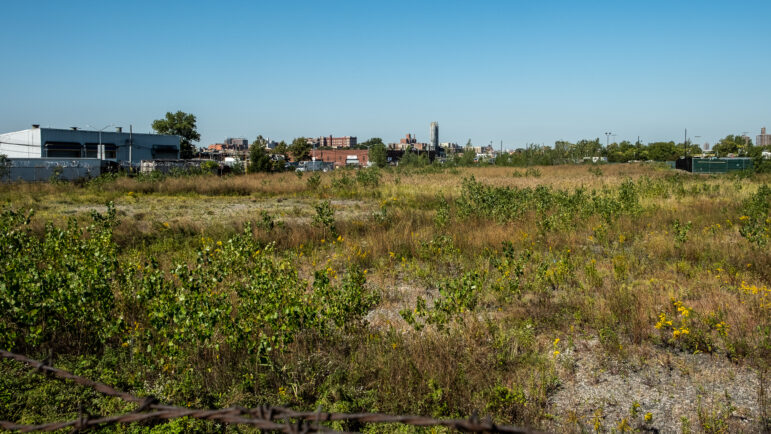A known carcinogen, Tetrachloroethylene is a chemical often used as a solvent for dry cleaning, and now fugitive traces of PERC can be found in many places around the city, including brownfields in The Bronx.

Adi Talwar
A Brownfield site at the South East corner of Food Center Drive and Halleck Street in Hunts Point, the Bronx.This project was produced by journalism students at CUNY’s Lehman College. Click here to read their main story, map and video investigation of contaminated brownfields in The Bronx.
Tetrachloroethylene (PERC) is on the EPA’s list of the 10 chemicals in most need of remediation. A known carcinogen, Tetrachloroethylene is a chemical often used as a solvent for dry cleaning, and now fugitive traces of PERC can be found in many places around the city.
The Bronx alone is home to hundreds of brownfield sites, 53 of which are under active remediation. The primary risk lies in the soil, as contaminated water trapped within eventually evaporates and breaks through via fumes. This toxic vapor can escape from the soil within buildings via cracks in the walls or the floor.
Dry cleaners use PERC because it was effective, expediting an otherwise time-consuming process as it was great at removing lubricants, oils, and a variety of stains. It is also less flammable than other cleaners. However, minor spills of the chemical can easily seep into soil and spread to the groundwater, making the area beneath such a dry cleaner toxic.
The danger PERC poses has been known since the 1970s. The compound is resistant to degradation and it easily spreads into the surrounding soil, which makes it a constant pollutant in an area much wider than its origin point. Efforts to limit or ban its use have failed. The chemical industry—really two firms that manufacture PERC—succeeded in beating back attempts to ban its use. While the World Health Organization (WHO) has concluded it is a known carcinogen, the EPA has been unable to get it out of use.
During the presidencies of both George W. Bush and Barack Obama, the EPA attempted to regulate and even outright ban the use of PERC. However, in 2016 President Donald Trump’s EPA, under the leadership of Scott Pruitt, hindered all attempts to curtail it.
As far back as 1976, under the Toxic Substances Control Act (TSCA), the EPA was granted authority over the reporting and testing regulations of chemical substances being used in the United States, focused primarily on the use of PCBs. Since 1988, members of the US Occupational Safety and Health Administration (OSHA) have attempted to regulate and outright ban the use of PERC, beginning with the decommissioning of machines that make use of the chemical near residential homes.

Adi Talwar
A Brownfield site adjacent to the Rainbow Garden of Life and Health on Melrose Avenue in the South Bronx.
On June 22, 2016, on the tail end of the Obama administration, The Frank R. Lautenberg Chemical Safety for the 21st Century Act was signed, amending the Toxic Substances Control Act. The Lautenberg Act said that the EPA needed to address certain chemicals currently used with a wary eye towards risk and needed to establish a clear deadline for evaluation.
The EPA has chosen against the calculation of PERC toxicity in soil, water, and air, and instead has narrowed its investigation to focus solely on direct exposure in work areas that utilize it. The primary reason for this is due to heavy pushback from members of the chemical industry, who profited off the use of the chemical and would be directly impacted by its regulation.
With heavy lobbying, the industry succeeded in greatly limiting the scope of the EPA’s evaluation. The chemical industry spent more than $221 million in lobbying for the preservation of PERC, implying that a focused investigation would expedite the development of more viable remedial actions.
Office of Chemical Safety and Pollution Prevention (OCSPP) press officer Cathy Milbourn declined to comment, instead pointing towards EPA’s public releases, and supporting documents to clarify the agency’s next steps.
In December of 2022, the final risk evaluation findings were published by the EPA, who concluded that out of the 61 evaluated conditions of use of PERC, 60 were found to be unreasonably harmful and toxic. The study also found an increased chance of latent cancer in subjects following their exposure to the chemical (it should be noted that this updated risk evaluation does not assume the appropriate protective gear is available or properly utilized in the handling of PERC.)
Public participation will play a large part in the EPA’s next actions, as they will factor comments from the public into their future regulatory actions against the chemical.
—Emmanuel Valerio and Pablo Reyes









2 thoughts on “What is PERC, and Why is There So Much in The Bronx?”
there are over 200 dry cleaner sites on the New York State Superfund list. See my article “Dry Cleaners: The Scourge of Commercial Property” available from my website.
Brilliant reporting, gives me hope for journalism yet.